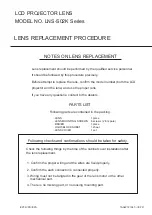
6
2. aCVi Overview
The following is a brief overview of the aCVi interface.
The basic concept of the aCVi interface is to build on the proven and
reliable transport method of NTSC, (the advantages of PAL
– v.v. multi-path
reception
– is not relevant to a cable system so NTSC is used as the
model). NTSC transmissions are capable of transmitting more than 1km
across RG-59 cable but the bandwidth is limited to 5MHz. NTSC also has
chroma/luma crosstalk issues that are difficult to resolve at the receiver
end.
Because the cable system is a closed system, it is only necessary for the
transmitter and receiver to ‘understand’ each other so we can modify the
basic NTSC method to suit HD transmissions.
The first thing to overcome is the bandwidth restrictions of the cable. HD
video transmission requires a luma bandwidth of 30MHz according to the
SMPTE-296M specification. Because we have only a single coaxial cable
for the transport we have chosen to transmit luma and colour difference
signals (as opposed to component red, green blue) as the colour difference
signals, because of the visual perception of the eye being less acute to
colour, can be sent at half or less of the luma bandwidth: for aCVi the
chroma bandwidth is 7.5MHz (effectively aCVi is 4:1:1 transmission).
To further reduce the bandwidth of the transmission the colour difference
signals are modulated onto a carrier in quadrature so they effectively use
the same bandwidth. However, to minimise the signal recovery problems of
NTSC, (and as we have no backward compatibility issues), the lower
sideband of the chroma and the luma high frequencies overlap minimally;
the chroma subcarrier for aCVi is set to ~41.4MHz. (See Figure 1).
For 300m of RG-59 cable we can expect 18dB loss at this frequency
(6.2dB/100m @ 50MHz). However the synchronizing signals are at a much
lower frequency where the loss is only about 1-2dB so reliable rastering of
the received signal should always be assured.
To simplify the high frequency compensation of the transmission, pre-
emphasis is used. The degree of pre-emphasis is programmable to allow
for different cable lengths. The maximum pre-emphasis is set at 30dB and
the frequency response of the pre-emphasis is set to approximate the cable
characteristics.
Содержание SM02
Страница 1: ...1 SM02 High Definition Video Encoder and Pattern Generator User Manual Revision 0 1 15 th March 2015 ...
Страница 13: ...13 Menu control The complete menu structure is shown in Figure 4 Figure 5 SM02 Menu structure ...
Страница 20: ...20 Figure 7 aCVi output 30MHz sweep Pre emphasis maximum Exit Returns to the top level menus ...
Страница 23: ...23 Figure 10 SMPTE Colour Bar component waveform Figure 11 SMPTE Reverse colour bars waveform ...
Страница 37: ...37 ...
Страница 38: ...38 ...







































